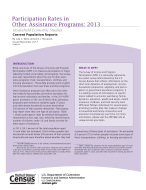Participation Rates in Other Assistance Programs: 2013
Participation Rates in Other Assistance Programs: 2013
Introduction
While one focus of the Survey of Income and Program Participation (SIPP) is to measure participation in major federally funded social safety net programs, the survey also asks respondents about the use of other assistance programs: food, transportation, clothing, and housing assistance. These data provide some insights into the population that uses these ancillary programs.
Other assistance programs are often part of an informal network that provides short-term assistance for low-income individuals and families. In the 2014 SIPP panel, questions on the use of these other assistance programs were limited to residents aged 15 years and older whose household incomes were below 200 percent of their poverty thresholds. Participants may report more than one type of assistance. Table 1 shows participation rates by selected demographic characteristics (sex, age, race, ethnicity, marital status, number of children under 18, and family income) for these types of assistance.
In 2013, 58.1 percent of the total population aged 15 and older (an estimated 139.9 million people) had household incomes below 200 percent of their poverty thresholds and were therefore asked whether they had received any of these types of assistance. An estimated 6.5 percent (15.6 million people) received some type of food, transportation, clothing, or housing assistance at any point during the year. Among these assistance programs, the one with the largest participation was food assistance followed by transportation, housing, and clothing assistance. An estimated 2.8 percent (6.8 million people) reported receiving food assistance. The most common type of food assistance, reported by 1.6 percent of the population (an estimated 4 million people), was the receipt of bags of groceries or packaged foods. This was followed by 1 percent of the population (approximately 2 million people) reporting the receipt of meals from a shelter, soup kitchen, Meals-on-Wheels, or meals from a charity.
In 2013, 2.7 percent of the population aged 15 and older (approximately 6.5 million people) reported receiving transportation assistance. The most common reason for transportation assistance was to get rides to a doctor’s office or medical appointment. An estimated 1.5 percent of the population (approximately 3.7 million people) received this type of transportation assistance. Out of the estimated 3.7 million people who reported receiving rides to a doctor’s office or medical appointment, 23.0 percent were covered by Medicare and 25.3 percent reported receiving Medicaid benefits. An estimated 2.1 percent of the population aged 15 and older (approximately 5 million people) reported receiving housing assistance and less than 1 percent (an estimated 1.7 million people) reported receiving clothing assistance.




